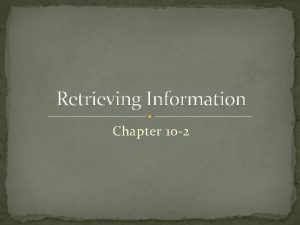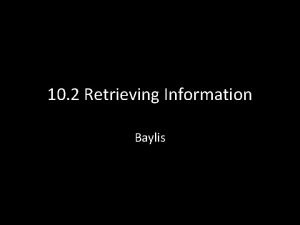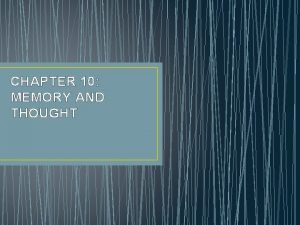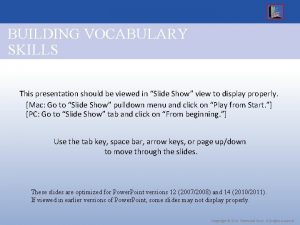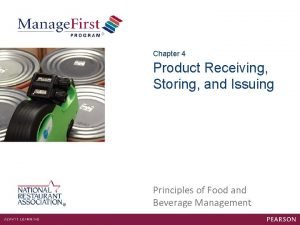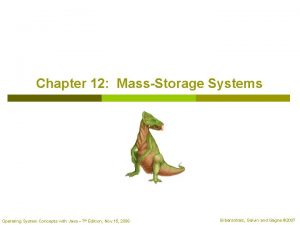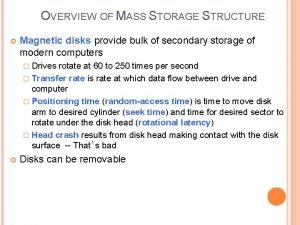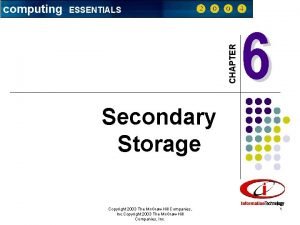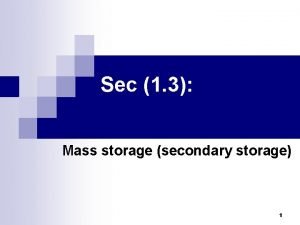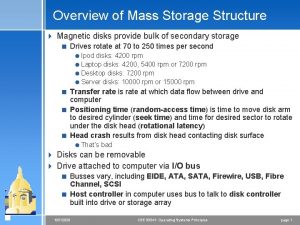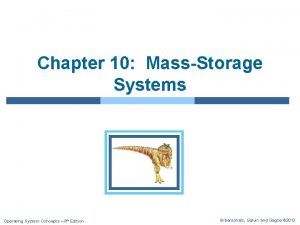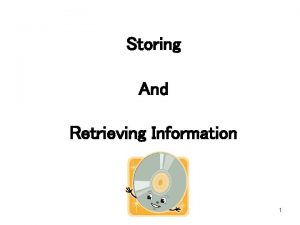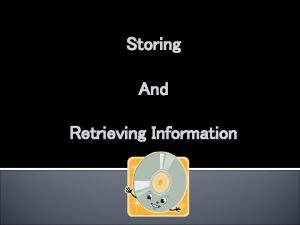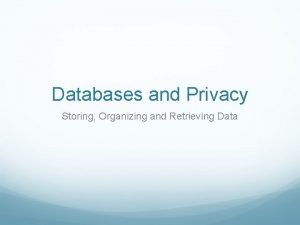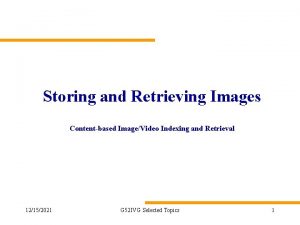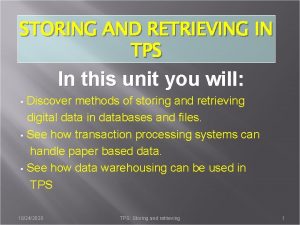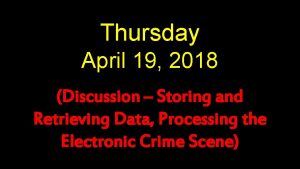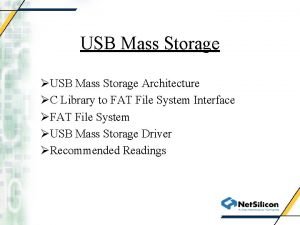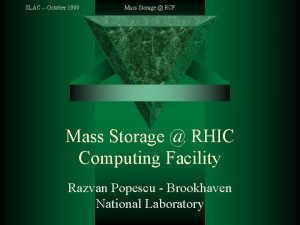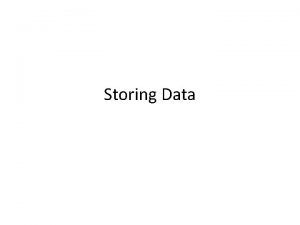Storing And Retrieving Information 1 Mass Storage and


















- Slides: 18

Storing And Retrieving Information 1

Mass Storage and Files �Programs and information (text, image, audio, video) are stored: ◦ Magnetic �Magnetic Tape �Magnetic Disk �USB ◦ Optical �DVD �CD-ROM �CD-RW • Other • USB FLASH • MO • Solid State Drives 2

Computer Files

Hard Disks � Faster and more storage than diskettes � Anatomy: ◦ ◦ Recording surface Multiple platters Read/write head Access arms Courtesy of Seagate Technology 4

Backing Up Files �Magnetic Tape used for: ◦ Backup or protection ◦ Archiving �Tape backup units (TBUs) �USB 2. 0(http: //www. everythingusb. com/usb 2/fa q. htm#1) �USB Portable Hard Drives 5

Backing Up Files � Backup methods: ◦ Full ◦ Selective ◦ Modified files only � Other backup options: ◦ Server computer ◦ Interchangeable external hard disk ◦ Online File Storage via FTP - (Win. SCP or Fugu) 6

Magnetic Disks Interchangeable Disks Can be stored offline and loaded to the magnetic disk drives as they are needed -Interchangeable Hard Disks -USB / Micro SD Cards Hard/Fixed Disks Permanently installed and cannot be removed - Data stored on all recording surfaces. - Allows greater density than interchangeable diskettes

Case & Inside 8

� Formatting is considered HARD DRIVE preparation. ◦ Initialize disk with recording format for your operating system. �Low-Level Formatting - Creates sectors and tracks on disk into which data are stored. �High Level Formatting - Sets up VFAT, Master Boot Record is created, copies hidden operating system files to the volume, and prompts you for a label i. e. MY Computer. http: //www. ranger. cc. tx. us/COSC_training/xstudy 5. htm � � Scan. Disk for lost clusters ◦ Sooner or later your PC will give a “lost clusters found” message, indicating that the hard disk has orphan clusters that don’t belong to a file. Typically, lost clusters are the result of an unexpected interruption of file activity, perhaps a system crash or loss of power. Windows users should run the Scan. Disk utility program periodically to “scan” the disk for lost clusters and, if any are found, let you return them to the available pool of usable clusters. Defragmentation 9

Head Crash

Magnetic Disk Organization � � Disk Address ◦ Tracks/Sectors/ �Clusters ◦ Cylinders Write data ◦ Magnetize disk’s thin coated surface Read data ◦ Sense absence or presence of a bit Magnetic Disks spin At Constant Angular Velocity

Magnetic Disk Organization VFAT: Virtual File Allocation Table ◦ Scan. Disk for lost clusters Defragmentation ◦ Re-Ordering Files Back into Continuos Clusters Formatting 12

VFAT: Writing a file File 1 st Cluster Expenses. xls Annual Rep. doc AVAILABLE New. Budget. md b 1 2 3 4 Cluster Track 3 1 Sector s 2, 3, 4, 5 13

VFAT: request for a particular file. 1. The operating system searches the VFAT to find the physical address of the first cluster of the file. 2. The read/write heads are moved over the track/cylinder containing the first cluster. 3. The rapidly rotating disk passes the cluster under/over the read/write head and the information in the first cluster is read and transmitted to RAM for processing. 4. The operating system checks an entry within the initial cluster that indicates whether the file consists of further clusters, and if so, where on the disk they are located. 5. The operating system directs that clusters continue to be read and their information transmitted to RAM until the last cluster in the chain is read (no further chaining is indicated). 14

DEFRAGGING YOUR HARD DRIVE 15

Optical Disks Spiraling Track Detector Pit Land Sector Less sensitive to environment Cheaper than magnetic disks Large data capacity Spins at Constant Linear Velocity

Optical Disks: Write-Only � CD-ROM ◦ ◦ Compact Disk: read only memory Cannot be altered Speeds: 32 X, 40 X or 75 X (spin rate) Capacity: 700 MB * � DVD-ROM ◦ Capacity: 4. 7 GB to 17 GB ◦ Backward compatible with CD-ROM

Optical Disks: Read/Write CD-R ◦ Compact diskrecordable CD-RW ◦ Compact diskrewritable ◦ Will not work with older CD-ROM drives DVD-RW DVD-RAM ◦ Rewritable
 10-2 retrieving information answers
10-2 retrieving information answers 10-2 retrieving information answers
10-2 retrieving information answers Taking in and storing information 10-1
Taking in and storing information 10-1 Chapter 10 sentence check 2
Chapter 10 sentence check 2 Transferring of data from auxiliary storage to main storage
Transferring of data from auxiliary storage to main storage Primary storage and secondary storage
Primary storage and secondary storage Uses rigid metallic platters
Uses rigid metallic platters Unified storage vs traditional storage
Unified storage vs traditional storage Food storing and issuing control
Food storing and issuing control Mass storage system in os
Mass storage system in os Mass storage system in os
Mass storage system in os Mass storage structure
Mass storage structure Mass storage devices are specialized high capacity
Mass storage devices are specialized high capacity Mass storage structure
Mass storage structure Mass storage is organized into
Mass storage is organized into Structure of magnetic disk
Structure of magnetic disk Mass storage structure in operating system
Mass storage structure in operating system Is atomic mass and relative atomic mass the same
Is atomic mass and relative atomic mass the same Difference between atomic mass and atomic number
Difference between atomic mass and atomic number
